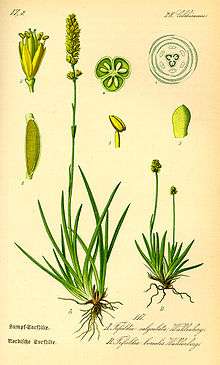Tofieldiaceae
Tofieldiaceae is a family of flowering plants in the monocot order Alismatales.[2] The family is divided into four genera, which together comprise 28 known species (Christenhusz & Byng 2016 [3]). They are small, herbaceous plants, mostly of arctic and subarctic regions, but a few extend further south, and one genus is endemic to northern South America and Florida. Tofieldia pusilla is sometimes grown as an ornamental.[4]
| Tofieldiaceae | |
|---|---|
 | |
| 2 species of Tofieldia from: Thomé (1885) | |
| Scientific classification | |
| Kingdom: | Plantae |
| Clade: | Tracheophytes |
| Clade: | Angiosperms |
| Clade: | Monocots |
| Order: | Alismatales |
| Family: | Tofieldiaceae Takht.[1] |
William Hudson (1730-1793) named Tofieldia for the British botanist Thomas Tofield (1730–1779).[5] The family Tofieldiaceae was erected by Armen Takhtajan in 1995.[6] Molecular phylogenetic studies of DNA sequences have shown it to be the second diverging clade in Alismatales, after the most basal clade, the family Araceae.[7] Before the segregation of Tofieldiaceae was confirmed by cladistic methods, its genera had usually been assigned to Nartheciaceae,[8] Liliaceae,[9] or Melanthiaceae. Tofieldiaceae is recognized by the Angiosperm Phylogeny Group in their APG III system of plant classification.
The circumscription of genera in Tofieldiaceae has been controversial. Many authors do not recognize Triantha as a separate genus from Tofieldia.[8][10][11] A few authors have sunk other genera into Tofieldia as well.[12] A phylogenetic analysis, based on two nuclear genes and ten chloroplast genes, has confirmed that all five of the genera are monophyletic and that Triantha and Tofieldia are close sister taxa.[13]
Description
Small herbaceous perennials. Leaves equitant (distichous and overlapping), isobifacial. Inflorescence a raceme. Calyculus present. Tepals free. Fruit a capsule, usually septicidal.
Phylogeny
The following phylogenetic tree is based on a DNA paper that was published in 2011,[13] modified to accommodate the transfer of the species in Isidrogalvia to Harperocallis.
| Tofieldiaceae |
| ||||||||||||||||||
References
- Angiosperm Phylogeny Group (2009). "An update of the Angiosperm Phylogeny Group classification for the orders and families of flowering plants: APG III". Botanical Journal of the Linnean Society. 161 (2): 105–121. doi:10.1111/j.1095-8339.2009.00996.x. Archived from the original (PDF) on 2017-05-25. Retrieved 2013-07-06.
- Vernon H. Heywood, Richard K. Brummitt, Ole Seberg, and Alastair Culham. Flowering Plant Families of the World. Firefly Books: Ontario, Canada. (2007). ISBN 978-1-55407-206-4.
- Christenhusz, M. J. M. & Byng, J. W. (2016). "The number of known plants species in the world and its annual increase". Phytotaxa. Magnolia Press. 261 (3): 201–217. doi:10.11646/phytotaxa.261.3.1.
- Anthony Huxley, Mark Griffiths, and Margot Levy (1992). The New Royal Horticultural Society Dictionary of Gardening. The Macmillan Press,Limited: London. The Stockton Press: New York. ISBN 978-0-333-47494-5 (set).
- Umberto Quattrocchi. 2000. CRC World Dictionary of Plant Names volume IV. CRC Press: Boca Raton; New York; Washington,DC;, USA. London, UK. ISBN 978-0-8493-2673-8 (set). (see External links below).
- Tofieldiaceae. At: International Plant Names Index. (see External links below).
- Peter F. Stevens (2001 onwards). "Tofieldiaceae" At: Angiosperm Phylogeny Website. At: Botanical Databases At: Missouri Botanical Garden Website. (see External links below)
- Minoru N. Tamura. 1998. "Nartheciaceae" pages ??. In: Klaus Kubitzki (general editor) with Klaus Kubitzki, Herbert F.J. Huber, Paula J. Rudall, Peter F. Stevens, and Thomas Stützel (volume editors). The Families and Genera of Vascular Plants volume III. Springer-Verlag: Berlin;Heidelberg, Germany. ISBN 978-3-540-64060-8 (vol. III).
- Frederick H. Utech, Loran C. Anderson, and John C. Packer. 2002. pages 5-6. In: "Liliaceae". pages ??. In: Flora of North America Editorial Committee. Flora of North America vol. 26. Oxford University Press: UK. ISBN 978-0-19-513729-3 (vol. 22). (see External links below).
- David J. Mabberley. 2008. Mabberley's Plant-Book third edition (2008). Cambridge University Press: UK. ISBN 978-0-521-82071-4
- Armen L. Takhtajan (Takhtadzhian). Flowering Plants second edition (2009). Springer Science+Business Media. ISBN 978-1-4020-9608-2.
- Wendy B. Zomlefer. 1997. "The genera of Tofieldiaceae in the southeastern United States". Harvard Papers in Botany. 2:179-194.
- Hiroshi Azuma and Hiroshi Tobe. 2011. "Molecular phylogenetic analyses of Tofieldiaceae (Alismatales): family circumscription and intergeneric relationships". Journal of Plant Research 124(3):349-357. doi:10.1007/s10265-010-0387-5
External links
| Wikimedia Commons has media related to Tofieldiaceae. |
- CRC World Dictionary of Plant Names: R-Z At: Botany & Plant Science At: Life Science At: CRC Press
- Tofieldiaceae at: Plant Names at: IPNI
- Genus List at: Tofieldiaceae at: Alismatales at: Trees at: APweb at: botanical databases at: About Science & Conservation at: Missouri Botanical Garden
- Harperocallis flava and Pleea tenuifolia and Tofieldia and Triantha at: Liliaceae at: Volume 26 at: FNA at: eFloras.org
- NCBI Taxonomy Browser
- links at CSDL, Texas